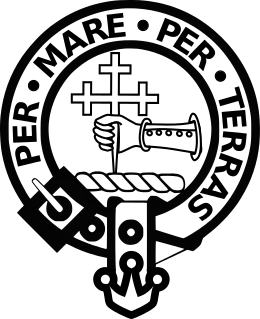Related Research Articles

North Uist is an island and community in the Outer Hebrides of Scotland.

Clan Campbell is a Highland Scottish clan. Historically one of the largest and most powerful of the Highland clans, their lands were in Argyll and the chief of the clan became the Earl and later Duke of Argyll.

Clan MacLean is a Highland Scottish clan. They are one of the oldest clans in the Highlands and owned large tracts of land in Argyll as well as the Inner Hebrides. Many early MacLeans became famous for their honour, strength and courage in battle. They were involved in clan skirmishes with the Mackinnons, Camerons, MacDonalds and Campbells, as well as all of the Jacobite risings.

The Campbells of Craignish, form one of the oldest branches of the ancient and powerful Clan Campbell in Scotland.. They claim descent from Dugald Campbell, the second son of Sir Archibald Gillespic Campbell (b.1130), 5th Knight of Lochawe and 20th Chief of Clan Campbell at the time. Sir Archibald's first son, Sir Duncan Campbell, 6th Knight of Lochawe, was the founder of the principal branch of the Campbell family who today holds the title Duke of Argyll.

Clan Macdonald of Sleat, sometimes known as Clan Donald North and in Gaelic Clann Ùisdein[kʰl̪ˠan̪ˠ ˈuːʃtʲɛɲ], is a Scottish clan and a branch of Clan Donald — one of the largest Scottish clans. The founder of the Macdonalds of Sleat was Ùisdean, or Hugh, a 6th great-grandson of Somerled, a 12th-century Lord of the Isles. The clan is known in Gaelic as Clann Ùisdein, and its chief's Gaelic designation is Mac Ùisdein, in reference to the clan's founder. Both the clan and its clan chief are recognised by the Lord Lyon King of Arms, who is the heraldic authority in Scotland.

The Battle of Coire na Creiche was a Scottish clan battle fought in the Isle of Skye in 1601. It was the culmination of a year of feuding between Clan MacLeod of Dunvegan and the Clan MacDonald of Sleat, that ended with a MacDonald victory in Coire na Creiche on the northern slopes of the Cuillin hills. It was the last clan battle in Skye.

.

The Battle of Carinish was a Scottish clan battle fought in North Uist in 1601. It was part of a year of feuding between Clan MacLeod of Dunvegan and the Clan MacDonald of Sleat, that ended with a MacDonald victory and an enforced peace.
Roderick Macleod, also known as Old Rory, was the chief of Clan Macleod of Lewes in the later half of the 16th century.
Séamus Mac Dòmhnuill aka Sir James MacDonald, 9th of Dunnyveg, was the last lord of Clan MacDonald of Dunnyveg or Clan Donald South.
Séamus Mac Dhòmhnaill aka James MacDonald, alias McDonnell, 6th Laird of Dunnyveg, Scot-Irish lord, died 1565.
Alexander Carragh Mac Dhòmhnaill, or Alexander MacDonald, 5th lord of Dunnyveg, alive c. 1480-1538.
Aonghus Mac Dòmhnuill, aka Angus MacDonald, 8th of Dunnyveg was the lord of Clan MacDonald of Dunnyveg.
The Battle of Ardnaree, was a battle in the Tudor conquest of Ireland fought at Ardnaree on 23 September 1586. The result was a victory for the English over the Mac Philbins and Burkes. The conflict was a part of the political and military struggle, involving the English and occasionally the Scots, for control of northern Ireland. Ardnaree the anglicised version of the name can be translated to Árd na ríogh meaning the hill of the kings.
Ranald MacDonald of Smerby, also known as Ranald MacJames was a son of James MacDonald, 6th of Dunnyveg and Agnes Campbell, daughter of Colin Campbell, 3rd Earl of Argyll. He was granted Smerby Castle from his father. He was a hostage for the good behaviour of his family together with his nephew James held by Sir Lachlan Mor Maclean. He was in charge of the garrison of troops within Loch Gorm Castle and surrendered the castle to Sir John Campbell of Cawdor on 28 January 1615. Ranald died in 1616, and was buried at Saddell Abbey.
Coll MacDonald was a son of James MacDonald, 6th of Dunnyveg and Agnes Campbell, daughter of Colin Campbell, 3rd Earl of Argyll. Upon mistakenly hearing that his brother, Ranald MacDonald of Smerby, had been killed at Duart Castle under orders of Sir Lachlan Mor Maclean, he executed 86 of Maclean's kinsfolk and servants at Mullintrae. Coll died at Eilean Mor, Knapdale. The rumour had been deliberately started by Allan Maclean, a magnate among the Macleans, who had hoped the rumour would cause Lachlan's death, which would have enabled him to increase his own influence.
Alexander Carragh MacDonald of Glenarm was a son of James MacDonald, 6th of Dunnyveg and Agnes Campbell, daughter of Colin Campbell, 3rd Earl of Argyll. Alexander, obtained possession of the barony of Glenarm. He was killed along with his brother, Donald Gorm, during the battle of Ardnaree, Ireland in 1586 against the English.
Sir John Campbell was a Scottish nobleman and knight, who was the son of Archibald Campbell, and Isabella Grant, a daughter of James Grant, laird of Freuchie and Elizabeth Forbes.
Events from the year 1586 in Ireland.

The blue men of the Minch, also known as storm kelpies, are mythological creatures inhabiting the stretch of water between the northern Outer Hebrides and mainland Scotland, looking for sailors to drown and stricken boats to sink. They appear to be localised to the Minch and surrounding areas, unknown in other parts of Scotland and without counterparts in the rest of the world.
References
- pp378-379, Rev. A. MacDonald & Rev. A. MacDonald; The Clan Donald
| This Scottish biographical article is a stub. You can help Wikipedia by expanding it. |